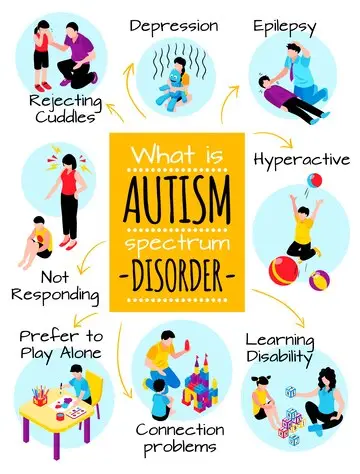Understanding ADHD and ASD: Differentiating Causes, Symptoms and Interventions

Introduction: Attention Deficit Hyperactivity Disorder (ADHD) and Autism Spectrum Disorder (ASD) are both neurodevelopmental conditions that can coexist or occur independently. Its wholly possible to have both which happens quite often. While they share some similarities in symptoms, they are distinct disorders with unique characteristics. This article aims to provide an overview of ADHD and ASD, differentiate their symptoms, and discuss intervention strategies tailored to each condition.

Page Contents
ADHD vs. ASD: Differentiating Causes

Attention Deficit Hyperactivity Disorder (ADHD) and Autism Spectrum Disorder (ASD) are both neurodevelopmental disorders, but they have distinct causes and characteristics.
ADHD (Attention Deficit Hyperactivity Disorder):
- Genetic Factors: There is a strong genetic component to ADHD. It tends to run in families, and specific genes associated with neurotransmitter function and brain development are implicated.
- Brain Structure and Function: Research indicates differences in the structure and function of certain brain regions involved in attention, impulse control, and executive function in individuals with ADHD. For example, the prefrontal cortex, which is responsible for executive functions like decision-making and impulse control, may develop differently.
- Neurotransmitter Imbalance: Dysregulation of neurotransmitters such as dopamine and norepinephrine is implicated in ADHD. These neurotransmitters play crucial roles in attention, motivation, and impulse control.
- Environmental Factors: Prenatal exposure to toxins like alcohol and tobacco, premature birth, low birth weight, and maternal stress during pregnancy are environmental factors that may increase the risk of developing ADHD.
ASD (Autism Spectrum Disorder):

- Genetic Factors: ASD is highly heritable, with multiple genes contributing to its development. Studies suggest that certain genetic mutations and variations are associated with an increased risk of ASD.
- Brain Connectivity and Structure: Individuals with ASD often exhibit atypical patterns of brain connectivity and structure. Differences in the growth and organization of neurons, as well as alterations in the white matter tracts that connect different brain regions, have been observed.
- Prenatal Factors: Exposure to certain prenatal factors, such as maternal infections, prenatal complications, and exposure to certain medications during pregnancy, may increase the risk of ASD. Additionally, advanced parental age at the time of conception has been linked to a higher likelihood of ASD in offspring.
- Environmental Factors: While genetics play a significant role, environmental factors also contribute to the development of ASD. These factors include prenatal and perinatal exposures, as well as early childhood experiences.
Differentiating Factors:
- Core Symptoms: ADHD is characterized by symptoms of inattention, hyperactivity, and impulsivity, whereas ASD is characterized by deficits in social communication and interaction, as well as restricted interests and repetitive behaviors.
- Onset and Presentation: ADHD symptoms typically manifest in early childhood and may persist into adolescence and adulthood. ASD symptoms also appear early in childhood but may be more variable in their presentation and severity.
- Neurodevelopmental Profiles: While both disorders involve differences in brain development and function, the specific patterns of atypical development differ between ADHD and ASD, leading to distinct behavioral profiles.
Understanding the unique genetic, neurological, and environmental factors associated with each disorder is crucial for accurate diagnosis, intervention, and support.
ADHD vs. ASD: Differentiating Symptoms
- ADHD (Attention Deficit Hyperactivity Disorder):
- ADHD is characterized by persistent patterns of inattention, hyperactivity, and impulsivity that interfere with functioning and development.
- Common symptoms include:
- Inattention: Difficulty sustaining attention, easily distracted, forgetfulness, and difficulty organizing tasks.
- Hyperactivity: Restlessness, fidgeting, excessive talking, and difficulty staying seated.
- Impulsivity: Acting without thinking, interrupting others, and difficulty waiting for turns.
- Individuals with ADHD may also experience executive function deficits, such as poor time management, difficulty planning, and impulsivity.
- ASD (Autism Spectrum Disorder):
- ASD is a complex neurodevelopmental condition characterized by persistent deficits in social communication and interaction, as well as restricted and repetitive patterns of behavior, interests, or activities.
- Common symptoms include:
- Social Communication Challenges: Difficulty with social reciprocity, nonverbal communication, and understanding social cues.
- Restricted and Repetitive Behaviors: Engaging in repetitive movements or behaviors, adherence to routines, intense interests, and sensory sensitivities.
- Difficulty with Flexibility: Resistance to change, insistence on sameness, and difficulty adapting to new situations.
- Individuals with ASD may also exhibit strengths in areas such as attention to detail, pattern recognition, and rote memory.
Intervention Strategies:
- ADHD Intervention:
- Behavioral Therapy: Cognitive-behavioral therapy (CBT) and behavior modification techniques can help individuals with ADHD develop coping strategies for managing symptoms, improving organizational skills, and enhancing impulse control.
- Medication: Stimulant medications, such as methylphenidate or amphetamines, are commonly prescribed to reduce hyperactivity, improve attention, and increase impulse control in individuals with ADHD.
- Classroom Accommodations: Providing structured routines, preferential seating, and frequent breaks can support individuals with ADHD in academic settings.
- ASD Intervention:
- Applied Behavior Analysis (ABA): ABA therapy focuses on addressing social communication deficits, teaching adaptive skills, and reducing challenging behaviors through structured, individualized interventions.
- Social Skills Training: Group-based interventions and social skills groups can help individuals with ASD learn and practice social skills, such as turn-taking, initiating conversations, and interpreting social cues.
- Sensory Integration Therapy: Occupational therapy interventions aimed at addressing sensory sensitivities and promoting self-regulation through sensory-based activities and accommodations.
Conclusion
ADHD and ASD are neurodevelopmental conditions with distinct symptom profiles and intervention strategies. While ADHD is characterized by inattention, hyperactivity, and impulsivity, ASD is characterized by social communication challenges, restricted and repetitive behaviors, and sensory sensitivities. By understanding the differences between these conditions and implementing tailored intervention strategies, individuals with ADHD and ASD can receive the support they need to thrive and reach their full potential.






